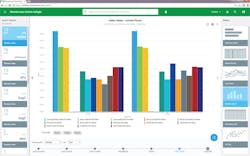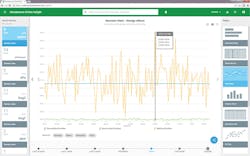The water utility industry faces a number of business challenges in the overall challenge of doing more with less, Schneider Electric points out.
Those challenges include maintaining infrastructure while expanding asset life, securing water supply in terms of quantity and quality in case of severe weather events such as drought and flooding, increasing staff productivity and effectiveness, meeting increasingly stringent regulations while being more energy and carbon efficient, and raising the bar of customer services quality to meet stakeholders’ expectations.
SCADA and data management technology as offered by Schneider Electric and other companies serve as primary tools in helping water utilities meet that mission of doing more with less.
Case in point: although Florida’s northeast coastal city of Fernandina Beach operates a small water utility, its management is based on practices common to larger water utilities—the use of SCADA and data management.
Some 80% of the water utility’s service is provided to the city’s 18,000 residents and 20% to other residents of Nassau County.
The utility operation has three interconnected water plants, with a water system rated for 18.1 mgd and a typical peak of 7.5 mgd. Its wastewater system has a discharge rating of 3.5 mgd and utilizes direct surface water discharge. There are 37 lift stations.
The operation runs on automation and data management, having adopted Data Flow System’s SCADA and automation solutions for years.
Fernandina Beach Utilities director John Mandrick is monitoring water utility operations using technology from Data Flow Systems.
“We definitely embrace automation,” says John Mandrick, utilities director. “We have a lot of security parameters to prevent it from being hacked or controlled. It’s a very robust system and Data Flow Systems is a key partner in that.”
Tom Hogeland, business development manager for Data Flow Systems, points out that the company offers full turnkey SCADA systems that allow for continual expansion without product obsolescence.
“A good example of that is our pump controller,” he says. “While we are on our fourth version of the pump controller, we still support all earlier versions and all of our equipment for as long as a utility wants to use it.”
The same holds true with the company’s software, which is also on its fourth version.
“A utility doesn’t have to worry about upgrading or retooling just because components are being phased out,” points out Hogeland.
Fernandina Beach has had various versions of Data Flow Systems technology since 1996 when the water system was put into place as a private, investor-owned utility before being acquired by the city of Fernandina Beach in 2003.
At that time, the city added Data Flow equipment on the sewer system to convert the entire system.
Mandrick favors Data Flow Systems for the fact that there are no annual fees for its use and there is around-the-clock technical support for its equipment. He also likes that it is customizable.
“You can make them look however you want,” he says. “They will train you in how to use their screen builder software. It’s very easy for somebody who’s not super computer literate to make the screens look the way they want them to look for their system.”
There are no fees involved in changing screens, says Mandrick.
“A lot of software or automation companies have proprietary screens and if you want to make a small change, you have to pay through the nose to get that done,” he adds.
Hogeland points out that his company’s data collection enables a utility to program pump run times “to where you can efficiently program your pumps to coincide with anticipated peak flows. Also, the data collection will allow you to analyze your flow volumes without relying on expensive in-line flow meters. We can mathematically tell you what your flows are just based on the pumping.”
Data collection also enables a utility to schedule preventative maintenance and identify problem areas prior to failure.
One of Data Flow System’s SCADA programs is Symphony, designed as harmonious pump and flow management to coordinate the system-wide operation of sewer lift stations to reduce force main pressures and equalize flow into a wastewater treatment plant for reduced energy costs, and to mitigate daily peak-flow challenges.
Symphony utilizes the combined functions provided by Data Flow Systems’ Hyper SCADA Server base station and the TAC Pack TCU pump-controller RTU at each lift station. Symphony acts to coordinate the random asynchronous operation of each lift station operating on a common force main by synchronizing the pumping activity on a minute-by-minute basis, reducing head pressures for more effective and efficient operations.
Mandrick notes a particularly favorable ROI on using data management for his utility’s sewer operation that focuses on the water-energy nexus.
“We cut our electric bill by more than 50%,” he points out. “Water is heavy. It weighs 8.34 pounds per gallon, so anytime you can avoid having to move it or control how it is moved to run more efficiently, you save huge dollars.
“In wastewater treatment, we’re able to optimize how our lift stations run and operate. That’s largely due to being able to monitor all of the data points that Data Flow Systems allows you to do.”
Additionally, the city’s water utility has hooked up its complete wastewater treatment trains to Data Flow Systems for monitoring dissolved oxygen (DO) and many other operating points in the plant.
“In just our wastewater plant, we have a reduction of more than 50% in electricity that was due to being able to monitor the DO, and do better DO control as well, since we moved away from blowers,” says Mandrick.
“We don’t use blowers in our wastewater treatment at all. That’s different from a lot of other utilities. We’re able to do that because we have a really good automation system.”
Another benefit: “With our automation system, the Florida Department of Environmental Protection allowed us to reduce our operational requirement at our plant—the number of hours we’re required to maintain an operator—by 50%,” says Mandrick. “In addition, we dewater sludge with no operator. There’s no supervision, it’s all fully automated.”
While Mandrick notes the utility has experienced numerous benefits for its investment in data management, a stark reminder occurred recently during the impact of Hurricane Matthew in early October.
“We were able to remotely monitor and control the system so that we could observe our emergency generators coming on like they are supposed to when the power failed,” he says. “We also could document when the power was restored because the emergency generators would shut down and the stations would go back to normal operation.
“We had the ability to do complete oversight and control and document both the water and sewer systems. Even though it was really inclement weather, the radio system had no issues and we didn’t have any issues on the entire system.”
Jeff M. Miller, water segment manager for Schneider Electric, notes that SCADA devices are enabling an increasing amount of intelligence and capabilities to water conveyance system devices.
“Everything from variable speed drives, to instrumentation, to even things like circuit breakers and motor controllers,” he adds. “That’s bringing down the cost and the ROIs in being able to do a lot of big data applications with analytics, helping with the communications and interconnectedness.”
By putting intelligence and communications capabilities into the devices, it allows water utility managers to gather significantly more information more efficiently and use it in “new and exciting” ways, says Miller.
One of the most significant ways is tapping into the growing interest in asset management in such a way that moves from manual data entry to automatic communications through SCADA, says Miller.
Schneider Electric’s technology is designed to go beyond that to condition management, Miller adds.
For instance, the company has software engaging in pattern recognition of equipment and processes “and if the pattern changes, we can alarm on that,” says Miller. “There’s not as much programming and knowledge needed to do very high-level application of equipment predictive maintenance and reliability.”
Wonderware software offers a graphical layout of a system.
The software’s user interface.
Going beyond IT or business systems convergence, the software is now “looking at engineering systems and operational systems and how do we combine those,” says Miller.
“For example, a lot of people heard of hydraulic models that engineers will use in the water industry to hydraulically model either their distribution systems or plants and they’ll connect that with their GIS systems,” says Miller. “That’s an engineering tool, not an online tool with real-time data. They use it for designs, do calculations with it, but they don’t use it operationally.”
Schneider Electric has designed a real-time tool combined with SCADA to enable water utility managers to see in real time how their systems react to various changes.
Avantis PRiSM is designed to be a user-friendly tool enabling water utility mangers to predict and forecast in real time the water’s efficiency, age, and any malicious or non-malicious intrusions into the system.
It also offers insight into how maintenance measures such as valve closures, changes in pressures, and taking tanks offline will affect the system.
The software offers a graphical layout of a system with color-coding and lines.
“It’s a matter of clicking on basic parameters you want to see and then you can take a slider and see what would happen in a period of time,” says Miller. “As you move that slider, you can see your system being forecast and how it would change.
“You can forecast if you close one valve, the people in this area will have a drop in pressure or if there’s a contamination event, you can predict where that contamination will spread in the system,” says Miller.
One of the functions of Avantis PRiSM is to support predictive maintenance programs by enabling users to transform raw data into actionable insights to prevent equipment failure and promote operational improvement.
PRiSM can be configured to monitor assets regardless of equipment type, vendor, or asset age.
Schneider Electric also offers Water Network Optimization Suite, which enables water utility managers to forecast system changes to make the correct operational decisions for efficiency, contaminations, water age, changes, and issues of maintenance, says Miller.
On its website, the company points out that while water utility managers monitor their distribution networks, acquiring data from network-critical points such as production and storage points and inlets of distribution zone, making them available in real time to operators in a centralized SCADA, the SCADA point data does not provide information regarding the rest of the network.
The Water Network Optimization Suite is designed to enable operations managers and control room operators to manage their network by incorporating virtual sensors providing information on hydraulic and water quality parameters at any point of the distribution network to enhance real-time supervision in SCADA.
The software evaluates the evolution of water network behavior, identifying potential issues regarding levels of service breaches such as pressure and water quality over ensuing hours and days.
It analyzes the results of an alternative “what-if” scenario, comparing it with the “business-as-usual scenario” without having to rely on hydraulic simulations run from other departments.
The software also analyzes a complete set of key performance indicators on energy usage, network pressure conditions, and water quality.
The software triggers alarms associated with potential anomalies detected by simulations, enabling operators to be warned of current critical network situations so immediate actions to prevent or mitigate service disruptions can be taken with sufficient lead time.
For instance, it can help answer questions such as how to know whether a reservoir’s water storage is sufficient to satisfy water demand during a weekend of rising temperatures, and how to see the effects of an alternative supply scenario for critical zones.
It is designed to provide evidence to help managers notify field technicians of an issue in a zone which requires urgent attention. It can help predict the effect of a valve operation in real time based on current network conditions.
Additionally, Wonderware Historian by Schneider Electric enables users to replay historical events on graphical SCADA screens.
“If you want to go back in time to an event and diagnose what happened, instead of just looking at history, trends of numbers, and trend screens showing graphs, you can look at your graphical screen you operate the system on and replay an event,” says Miller.
The ability now to network smart devices instead of hardwiring signals gives utilities more options in accessing data, Miller points out.
The ability offered through intelligent motor control centers offers big data benefits through energy monitoring and management and more data for doing more maintenance, he adds.
While utilities can pull more data than ever before, the next step is to leverage it, says Miller.
“You’re not just doing corrective actions, but preventative and predictive,” he says.



